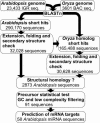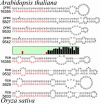Detection of 91 potential conserved plant microRNAs in Arabidopsis thaliana and Oryza sativa identifies important target genes
- PMID: 15272084
- PMCID: PMC509231
- DOI: 10.1073/pnas.0404025101
Detection of 91 potential conserved plant microRNAs in Arabidopsis thaliana and Oryza sativa identifies important target genes
Erratum in
- Proc Natl Acad Sci U S A. 2005 Mar 22;102(12):4655
Abstract
MicroRNAs (miRNAs) are an extensive class of tiny RNA molecules that regulate the expression of target genes by means of complementary base pair interactions. Although the first miRNAs were discovered in Caenorhabditis elegans, >300 miRNAs were recently documented in animals and plants, both by cloning methods and computational predictions. We present a genome-wide computational approach to detect miRNA genes in the Arabidopsis thaliana genome. Our method is based on the conservation of short sequences between the genomes of Arabidopsis and rice (Oryza sativa) and on properties of the secondary structure of the miRNA precursor. The method was fine-tuned to take into account plant-specific properties, such as the variable length of the miRNA precursor sequences. In total, 91 potential miRNA genes were identified, of which 58 had at least one nearly perfect match with an Arabidopsis mRNA, constituting the potential targets of those miRNAs. In addition to already known transcription factors involved in plant development, the targets also comprised genes involved in several other cellular processes, such as sulfur assimilation and ubiquitin-dependent protein degradation. These findings considerably broaden the scope of miRNA functions in plants.
Figures


References
-
- Bartel, D. P. (2004) Cell 116, 281-297. - PubMed
-
- Carrington, J. C. & Ambros, V. (2003) Science 301, 336-338. - PubMed
-
- Lai, E. C. (2003) Curr. Biol. 13, R925-R936. - PubMed
-
- Lee, R. C., Feinbaum, R. L. & Ambros, V. (1993) Cell 75, 843-854. - PubMed
-
- Wightman, B., Ha, I. & Ruvkun, G. (1993) Cell 75, 855-862. - PubMed
Publication types
MeSH terms
Substances
LinkOut - more resources
Full Text Sources
Other Literature Sources
Molecular Biology Databases

